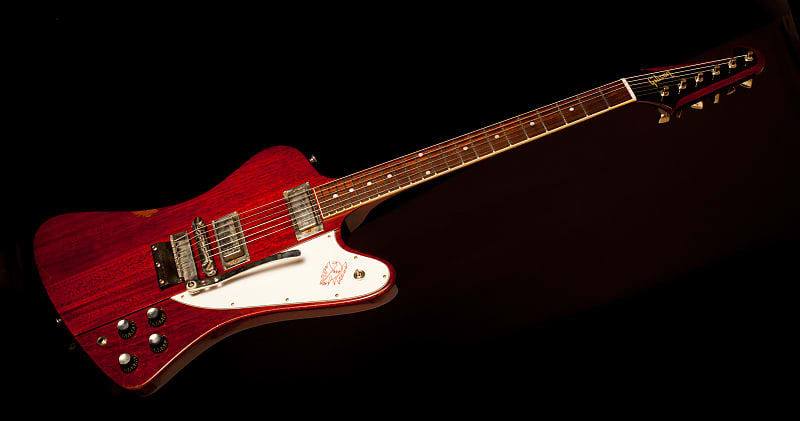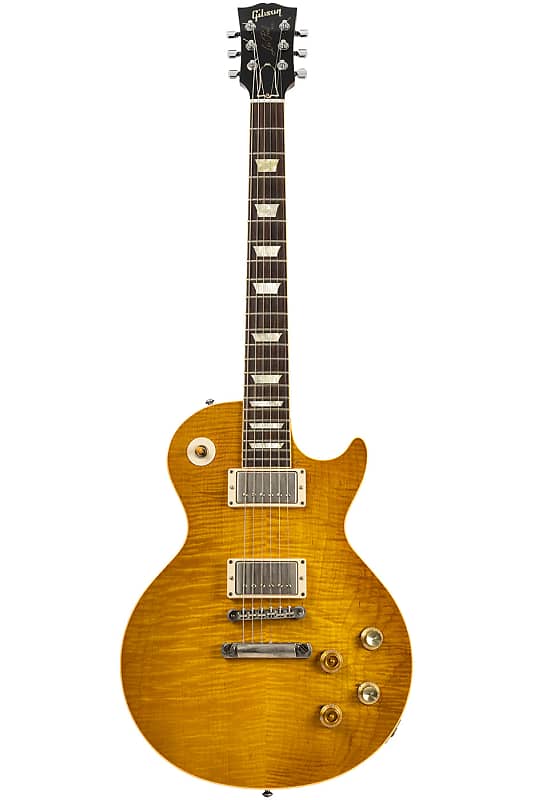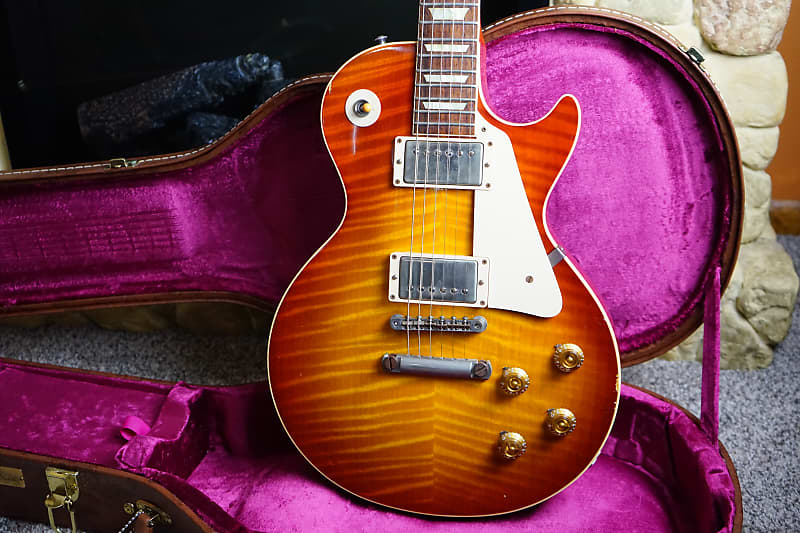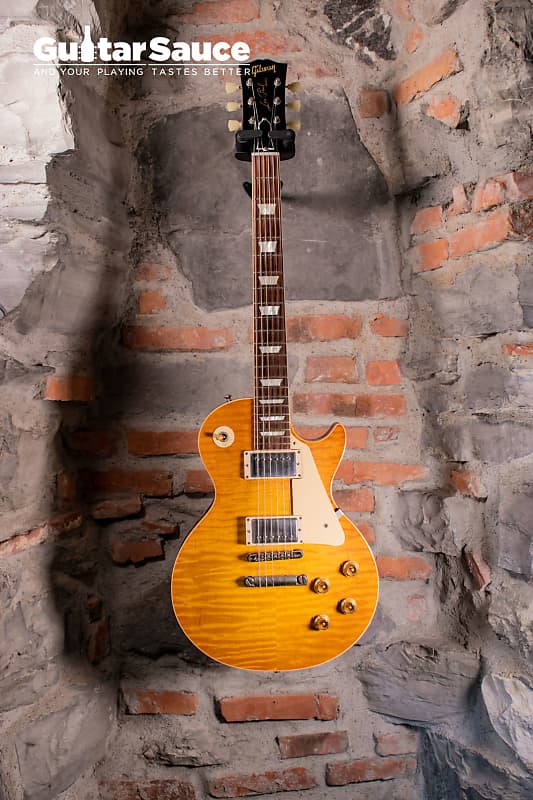Between 2010 and 2017, the Custom Shop at Gibson produced 39 different models grouped together as the limited-edition Collector’s Choice series. According to Gibson, the series would "crack open the greatest vaults of vintage instruments in the world, allowing players the opportunity to own replicas of one-of-a-kind historic guitars. We’ve contacted some of the world’s most prominent collectors of rare instruments and convinced them to share their greatest prizes in this unique and unprecedented program."
The Custom Shop pulled together two primary aspects of its existing work: Tom Murphy’s aging techniques, which it had first called upon in 1999; and artist-related Les Pauls, which for the Shop had started with the Gary Rossington model of 2002. And for Collector’s Choice (we’ll call it CC) the Shop drew inspiration not just from guitars owned or once owned by notable players, but also from instruments revered among the specialist community of Burst collectors.
Most of the CCs were indeed based on famous and admired Les Pauls—32 Burst re-creations, two ’57 Goldtops, a ’68 Goldtop, a ’59 Custom, and a ’59 Junior—and also a 335 and a Firebird III. They were expensive items, with list prices originally at $9,000 or so up to nearly $15,000.

The idea came from discussions between Edwin Wilson and Rick Gembar at Gibson’s Custom division—Rick was the division’s general manager and a Gibson senior vice president, Edwin the historic program manager, engineering—together with a group of collectors including Ronny Proler, who has collected Bursts since he bought his first one in the mid ’70s.
Ronny has some good memories of the CC series. "I brought in some of my friends and their guitars—Vic DaPra, Joe Bonamassa, Charlie Daughtry, all the first ones—and I’m really very proud of the Collector’s Choice programme," he tells me. "We got to make a lot of really good changes, everything from binding and rolling and frets and colors and relic-ing, making different knobs, different tuner tips, different cases. It really was a fun programme."
Edwin told me later about the CC series from Gibson’s point of view. "We figured that the world needed to know that we had access to the great guitars that these collectors own—that we could scan them, we could document them," he said. "And this knowledge would help validate everything that we were working on to do with the accuracy and prestige of our reissues, well developed at the time with the R9s and the rest. We needed to let people know this, and these guitars were a way to do that."

The Gary Moore/Melvyn Franks Les Paul, released in 2010, was the first model that Gibson announced as a CC guitar, and it combined two attributes: it was a nitpicking re-creation of a great player’s guitar—the original ex-Peter Green, ex-Gary Moore Burst—and it was owned by a collector, Melvyn Franks. (Famously, it would later be acquired by Kirk Hammett.)
CC number 2, a Burst known as Goldie, set the style for many of the instruments that followed. It reproduced a gorgeous original Burst with a suggested issue limit of 300 aged examples—and, in this case, there was also a slightly later batch limited to 50 in cherry gloss finish—and it came with a Custom Shop certificate signed by Rick Gembar.
In its sales material for Goldie, the Shop revealed some of its methods that would apply to most of the CC series. "Working with a specific ’59 and its owner allowed Gibson Custom full access so that it could be analyzed, digitally scanned, and measured from every conceivable perspective."
Gibson accepted a shortcoming of the approach, that nobody could know now what a particular guitar had looked like, or felt like, or sounded like in the year of its birth. "What is known is the guitar as it looks, feels, and plays today; the effects of time, light, dust, DNA, and every encounter that it has had over the last 50 years have resulted in what Gibson Custom has worked so hard and for so long to bring to a very limited number of owners."
Vic DaPra got his first Burst in 1972, and he’s published six Burst Believers books that profile Les Paul owners and their axes. He reckons Gibson started the CC series to fill a gap in the Custom Shop’s offers. "They had the reissues, and they were getting truer and truer and closer and closer to a real Burst," Vic tells me. "But they were almost always new and shiny, and I think they were looking for something with that wear and tear on it, something that felt more like a Burst."

Vic was unique in the CC series in that the Shop repro’d four of his Lesters for the programme, more than anyone else. The first was CC number 9, a ’59 known as the Believer Burst. "That’s always been my favorite," he says. "That guitar and the Brock Burst were the two main poster Bursts in the ‘80s. For the Collector’s Choice deal, Gibson usually announced a maximum of 300 guitars," he says, "and I think they made 87 or 88 of the Believer Burst—and that was it. I guess they couldn’t get that wood." Gibson did add a comment to the edition limit on some CC spec sheets that the "availability of qualifying materials" would "ultimately determine the final number," and so often there were far fewer than 300 produced.
Next for Vic in the CC series came number 30, called the Gibson Appraisal Burst, or Gabby for short ("appraisal" refers to the way Gibson would sometimes get calls on vintage guitars and turn callers on to a few select contacts, including Vic). He was disappointed with the results for this one. "You look at the original, and you look at the Collector’s Choice guitars, and I thought, ‘Oh my—come on guys, what are you looking at?’"
Then came CC number 35 for Vic, in 2016, the Gruhn Burst. Vic had acquired the original ’59 from Dino Bradley, who played in a band with Hank Williams Jr and worked at the Gruhn store in Nashville. "That’s probably the most flamey Burst I’ve ever seen in my life," he says, "just a crazy, insane top. I’ve seen some amazing examples of that Collector’s Choice they did. Gibson came back pretty strong on that one and did a nice job."

Last for Vic in the CCs came number 44, Happy Jack. The original ’59 has a distinctively irregular and wide flame top and pleasing color. "It looks like an autumn color," Vic reckons, "a really faded, beautiful color. Gibson came pretty close on the color, and some of the tops were OK, but they really had a hard time matching up the flame with that one."
The CC programme ground to a halt in 2017, but it had created remakes of some fine instruments, including guitars owned by collectors Drew Berlin, Tommy Colletti, Vic DaPra, Charlie Daughtry, Ronny Proler, Andrew Raymond, Mike Reeder, Mike Slubowski, Robbert J. van der Ende, and Tom Wittrock, and by players Joe Bonamassa, Scott Bradoka, Jeff Hanna, Gordon Kennedy, Ed King, Bernie Marsden, Greg Martin, Ronnie Montrose, Keith Nelson, Tamio Okuda, Mick Ralphs, Tom Scholz, John Shanks, JD Simo, Waddy Wachtel, and Brad Whitford, as well as a few where the owner preferred anonymity.
Maybe the CC series had come to a natural finish. But it seems no coincidence that the programme did not survive the departure from the Custom Shop that same year, 2017, of Rick Gembar (23 years at Gibson) and Edwin Wilson (32 years) during a messy upheaval that many Gibson fans could not understand. Gibson’s boss, Henry Juszkiewicz—whose Goldtop starred as CC number 12—would leave the following year in the wake of the firm’s Chapter 11 bankruptcy filing.
Despite some criticisms, Vic DaPra looks back on the CC series with pride. "I think it was a great asset for Gibson, a great introduction to the reissue line. To me, it seemed like it really started off strong, but it slowed down. There were some amazing examples—and there were some real clunkers." Still, for Vic, nothing beats an original, like the Believer Burst. "It’s all about opening up that case and seeing that wood," he says. And smelling that smell as you lift the lid, too, surely? He laughs: "And the smell, exactly! They still haven’t got the smell right. Not yet."
Collector's Choice Checklist
This listing organizes the CC series by year of issue. Each entry shows the Edition number and Official model name, a short description of the replicated instrument, the name of the contemporary owner (and original owner or owners where relevant), and in a few cases any serial-number variants. Edition numbers 20, 21, 23, 25, 27, 32, 40, 41 are missing because they were not issued.
2010
1. Gary Moore/Melvyn Franks / ’59 Standard 9 2208 / Melvyn Franks (Peter Green, Gary Moore) / CC 01A… Gary Moore version, Aged Butterscoth; CC 01V… Melvyn Franks version, V.O.S. Butterscotch. See it here.
2011/12
2. 9-0629 a.k.a. Goldie / ’59 Standard 9 0629 / anonymous/ CC 02A… aged No Burst; CC 02G… not-aged Cherry Gloss. See it here.
2012
3. 0-0137 a.k.a. The Babe / ’60 Standard 0 0137 / Joe Bonamassa. See it here.
4. 9-1228 a.k.a. Sandy / ’59 Standard 9 1228 / Tom Wittrock / CC 04A… aged Green Lemon; CC 04V… lightly-aged V.O.S. See it here.
6. 9-1918 a.k.a. Number One / ’59 Standard 9 1918 / Mike Slubowski.
2013
7. 0-0298 / ’60 Standard 0 0298 / John Shanks. See it here. 8. 9-1914 /’59 Standard 9 1914 / Bernie Marsden. See it here. 9. The Believer Burst / ’59 Standard 9 0850 / Vic DaPra. See it here. 10. 529263 / ’68 Goldtop 529263 / Tom Scholz. See it here. 11. Rosie / ’59 Standard 9 0925 / anonymous. See it here. 13. Spoonful Burst / ’59 Standard 9 1352 / Gordon Kennedy (John Sebastian). See it here. 15. 8-6576 / ’58 Standard 8 6756 / Greg Martin. 16. Redeye / ’59 Standard 9 0891 / Ed King. See it here.
2014
12. 7-3939 / ’57 Goldtop 7 3939 / Henry Juszkiewicz. See it here. 14. Wachtel Burst / ’60 Standard / Waddy Wachtel. 17. Louis / ’59 Standard 9 1062 / Keith Nelson. See it here. 18. Dutchburst / ’60 Standard 011167 / Robbert van der Ende. See it here. 26. Whitford Burst / ’59 Standard 9 0653 / Brad Whitford. See it here. 28. STP Burst / ’58 Standard 8 6787 / Estate of Ronnie Montrose. See it here. 30. Gibson Appraisal Burst/Gabby / ’59 Standard 9 0291 / anonymous. See it here.
2015
5. Donna / ’59 Standard 9 1923 / Tom Wittrock. See it here. 22. 9-0984 / ’59 Custom 9 0984 / Tommy Colletti. See it here. 24. Nicky / ’59 Standard 9 1945 / Charles Daughtry. See it here. 29. 9-1165 / ’59 Standard 9 1165 / Tamio Okuda / CC 29A… Aged Sunburst; CC 29V… lightly aged V.O.S. Sunburst. See it here. 33. 0-2176 / ’60 Standard 0 2176 / Jeff Hanna. See it here. 34. Blackburst / ’60 Standard 0 0162 / anonymous.
2016
19. 932517 / ’59 Junior 932517 / anonymous. 35. Gruhn Burst / ’59 Standard 9 0627 / Vic DaPra. See it here. 36. Goldfinger / ’57 Goldtop 7 3308 / Charles Daughtry. 37. Carmelita / ’59 Standard 9 1953 / anonymous. See it here. 39. 9-1105 a.k.a. Minnesota Burst / ’59 Standard 9 1105 / Andrew Raymond. See it here. 42. 72739 / ’62 ES-335TDC 72739 / JD Simo. 45. Danger Burst / ’59 Standard 9 0676 / anonymous.
2017
31. 9-0799 / ’59 Standard 9 0799 / Mike Reeder. 38. Chicken Shack Burst / ’60 Standard 0 0205 / Drew Berlin (Stan Webb). 43. Mick Ralphs / ’58 Standard 8 7049 / anonymous (Mick Ralphs). See it here. 44. 9-2072 a.k.a. Happy Jack / ’59 Standard 9 2072 / Vic DaPra. 46. Kathryn / ’59 Standard 9 2023 / Scott Bradoka. See it here. 47. 235304 / ’64 Firebird III 235304 / anonymous. See it here.
About the author: Tony Bacon writes about musical instruments, musicians, and music. His books include Legendary Guitars and Sunburst. Tony lives in Bristol, England. More info at tonybacon.co.uk.
